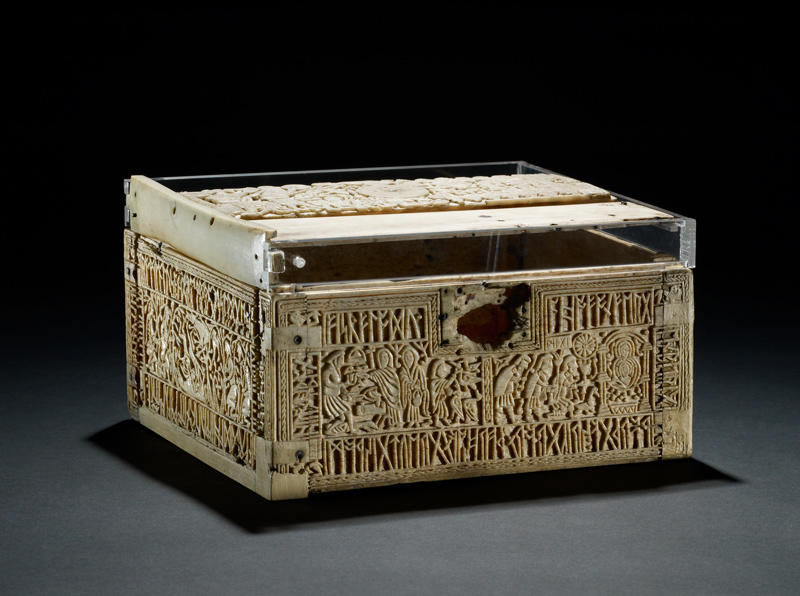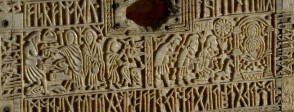
Christian Northumbria
The casket was probably intended to contain a copy of a religious book such as the Gospels or Psalms. Its style suggests it was made in Northumbria and dates to around AD 700. At this time, Northumbria was the largest and one of the most powerful of the Anglo-Saxon kingdoms. It was also a stronghold of Christianity. During the early AD 600s, Northumbria followed the Irish form of Christianity established there by St Aidan, who founded the monastery of Lindisfarne. Tensions with the Roman church, which was stronger in the other kingdoms, were resolved at the Synod of Whitby in AD 664 and Northumbria adopted the Roman church. By the time the casket was made, the twin monastery at Monkwearmouth-Jarrow was in the process of becoming one of the most important centres in Europe for Christian scholarship.
The stories shown
The casket has five faces, all decorated with scenes from recognisable stories. The front of the casket is divided into two zones. On the left is a scene from the story of Weland the Smith, a violent pagan legend known both in Anglo-Saxon and north European versions. On the right is depicted the Adoration of the Magi, when the three wise men visited the new-born Christ. The panel on the left end shows Romulus and Remus, twin brothers brought up by a wolf in Roman legend. The back shows the capture of Jerusalem in AD 70 by the Roman emperor Titus. The right-hand end and the lid have scenes from other Anglo-Saxon stories.
Only one of these stories is Christian; the others are drawn from pagan contexts: Anglo-Saxon legend, ancient Roman legend and ancient Roman history. This demonstrates the way in which different cultural and religious traditions co-existed in England and offered Anglo-Saxon artists a rich source of narrative and motif on which to draw. Scholars suggest that the juxtapositions of these scenes from different traditions bring out a number of specific themes: life and death, exile, and salvation.
Anglo-Saxon culture and literacy
The complexity of the scenes and the inscriptions in runes and other scripts indicate that the audience for which the casket was produced was well-educated. Understanding of the Christian scene derived from other visual representations of the Adoration and from hearing it recounted, though ultimately the scene had its basis in the written word of the Bible. The same applies to the Roman scenes. These probably derived from visual or literary versions encountered through contemporary contact with Roman culture rather than through any familiarity that had lingered since the Roman occupation of Britain some 300 years earlier.
In contrast, the Anglo-Saxon stories on the casket are examples of oral traditions of storytelling passed on over hundreds of years. Storytelling was a form of entertainment and many stories would be heard around the fire in the evenings, but it was also used on formal occasions when important matters of legitimacy and social identity were consolidated by the retelling of oral histories. Not long after this casket was made, some of these Anglo-Saxon stories, which existed in several oral versions, became crystallised into a single version and were then written down. The most famous example of this is the story of Beowulf, a long epic poem which some scholars believe was first written down in Northumbria around the middle of the AD 700s.
Another Anglo-Saxon cultural form was riddling. One expert argues that the whole casket is a riddle to be worked out by the owner. Certainly, one of the inscriptions - on the front - poses a riddle about what the casket is made of. It reads: “The fish beat up the seas onto the mountainous cliff; the king of terror became sad when he swam onto the shingle.” This refers to the beached whale from whose bone the casket was made. This way of hinting at meaning rather than saying something directly occurs in another feature of Anglo-Saxon poetic language known as kennings. Kennings combine words to create an often beautiful image, for example, the sea is called the whale-road and a ship is called a sea-stallion. The poem Beowulf contains over a thousand kennings.
More information
Casket
British Museum article about the casket.
http://www.britishmuseum.org/explore/highlights/highlight_objects/pe_mla/t/the_franks_casket.aspx
Anglo-Saxon settlement in Britain
BBC History article about the early years of Anglo-Saxon settlement in Britain, and the conversion of kingdoms to Christianity.
http://www.bbc.co.uk/history/ancient/anglo_saxons/overview_anglo_saxons_01.shtml#five
Tale of Weland the Smith
British Museum lesson plan for the tale of Weland the Smith.
https://www.britishmuseum.org/docs/Franks.doc
Roman identity and British Christianity
Article from British Archaeology magazine about the continuation of Roman identity and British Christianity after the departure of the Roman legions and officials.
http://www.archaeologyuk.org/ba/ba68/feat1.shtml
Anglo-Saxon story of Beowulf
Information about the Anglo-Saxon story of Beowulf from the British Library.
http://www.bl.uk/onlinegallery/onlineex/englit/beowulf/
The Franks casket
Leslie Webster, The Franks casket, British Museum Press, 2012.
http://www.britishmuseumshoponline.org/invt/cmc28184?ref=searchzone
More information
-
Casket
British Museum article about the casket.
Source: britishmuseum.org
-
Anglo-Saxon settlement in Britain
BBC History article about the early years of Anglo-Saxon settlement in Britain, and the conversion of kingdoms to Christianity.
Source: britishmuseum.org
-
Tale of Weland the Smith
British Museum lesson plan for the tale of Weland the Smith.
Source: britishmuseum.org
-
Roman identity and British Christianity
Article from British Archaeology magazine about the continuation of Roman identity and British Christianity after the departure of the Roman legions and officials.
Source: archaeologyuk.org
-
Anglo-Saxon story of Beowulf
Information about the Anglo-Saxon story of Beowulf from the British Library.
Source: bl.uk
-
The Franks casket
Leslie Webster, The Franks casket, British Museum Press, 2012.
Source: britishmuseumshoponline.org


